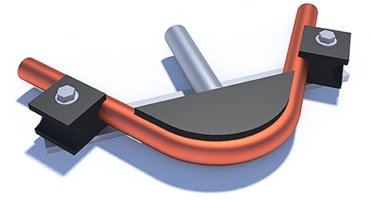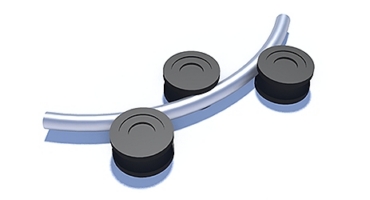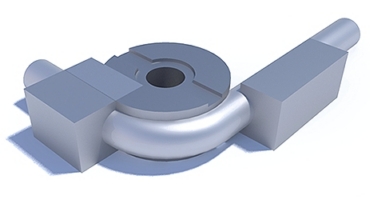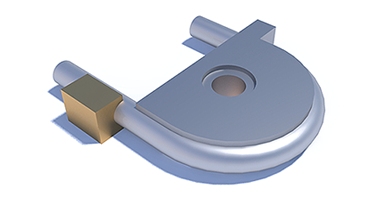
Tube bending methods and technologiesEven with the possibility to read this theme in Wikipedia we wrote this article to make some our explanation for tube and bending methods and technologies. We hope it will help everybody to understand more about tube bending, moreover pluses and minuses for each way of bending.Tube bending as technologyTube bending technology itself is the way for the proper deformation of the straight tube to obtain the bend with necessary angle and radiuses. There are diffent way with the use of tools and machines we are trying to explain below. Tube bending technology leads to the fabrication of tubular components and goods, special tube- and pipelines for different kind of applications. With the last years tube bending technologies made a big step thanks to the development of precision controls and scales, servodrives and power units to make even hard and sofisticated bends with the perfect quality.In fabrication general process tube bending usually is the secondary technology, not so important as turning and milling and completely different as the deformation technology. In a lot of ways tube bending principles are used not only for round tubes but for the wire and bars, oval, square and rectangle tubing. The described technologies are cold technologies of bending which means that there is no any tube heating process before and during the deformation to perform the bend and change the structure or shape. In general tube bending technologies are require separate set of tube bending tooling or for each radius or according to the size of tube (3 roll bending). Bow tube bending technology Bow bending or arbalet bending, or arc bending, or ram bending is one of common and general way to perform the bending of tube, in particular with soft materials and big radius. Bow bending or arbalet bending, or arc bending, or ram bending is one of common and general way to perform the bending of tube, in particular with soft materials and big radius.The principle of the technology: tube is holded from both sides with free clamps (or in other terminology - counter dies) and the main die or radius block will be moved forward - to the center point between the clamps to perform the bend with the force movement. In the past this type of tube bending could be used with even for big and thick tubes with the special tools and hydraulic press force. Moreover fifty years ago this principle of bending was used even for naval industry. Bow bending is the oldest indusrial technology for tube bending. The force could be obtain with the use of pneumatic, hydraulic or other force unit. Moreover the same technology could be used as optional technology with horizontal hydraulic presses to bend tubes and bars. Bow tube bending is one bend technology. It means that there is no any unit to control the lengths between bends so it is impossible to perform 2 precision bends with the required length between them. So the main use of the technology today are the handy tools for service and repair with the work with soft materials. Advantages: Simple and cheap technology Simple tools with the universal possibilities for clamps Wide use with handy tools Disadvantages: Big radiuses Usually used for soft materials like copper Technology to perform one bend 3 roll tube bending technology 3 roll bending technology is the wide today fabrication technology with the use of manual and industrial profile bending or section bending machines (profile benders or section benders). This technology is perfect one for big radiuses and the only one method for deformation of big diameter of tubes like 300, 400, 500 mm diameter in cold without heating. This means that the technology could be used from small sizes till big pipelines, for example for steel constructions or pipelines.
3 roll bending technology is the wide today fabrication technology with the use of manual and industrial profile bending or section bending machines (profile benders or section benders). This technology is perfect one for big radiuses and the only one method for deformation of big diameter of tubes like 300, 400, 500 mm diameter in cold without heating. This means that the technology could be used from small sizes till big pipelines, for example for steel constructions or pipelines.The principle of technology: tube is holded between rollers, two on the bottom and one on the top. Top roller could be adjusted according to the vertical position and this means the connection with the formed radius. Several or all rollers are driven to make the tube passing through the rollers. So this method has no additional force for deformation except the rollers position and it hels to make better bends. Radius of bending is connected with the machine possibilities, sizes and rollers positions but usually is big and could be obtained if more than five diameters of tube. 3 roll bending (there are some manufacturers to add the fourth roller in the process but in general the way of bending is the same) is quite effective method for big radiuses applications and widely used for today. Because of impossibility to control normally the feeding of tube with manual or conventional machines any tube bending process with several bends could be performed with the use only of CNC machine. Advantages: Economic technology Differrent radiuses with one set of tooling Wide use with big radiuses Disadvantages: Big radiuses Change of radiuses in one part requires CNC machine No length control Draw tube bending technology Draw tube bending technology is the classic technology of today tube bending. It was developed dozens of years ago but the most popular for today because with it you can obtain the best precision and controlled bending against all other ways to bend the tube. That is why today lot of automotive components, conditioning tubing, liquid lines are made with the use of tubes after draw tube bending process. Draw tube bending technology is the classic technology of today tube bending. It was developed dozens of years ago but the most popular for today because with it you can obtain the best precision and controlled bending against all other ways to bend the tube. That is why today lot of automotive components, conditioning tubing, liquid lines are made with the use of tubes after draw tube bending process.The principle of technology: tube is clamped with the front clamp and bend die clamp and is bended according to the rotation of bend die itself. Rear clamp or pressure die follows the tube and helps to prevent any tube inclination. You can also check our visualization for draw tube bending process. The one of most important point that draw tube bending process is mandrel bending which means the use of mandrel - tool to go inside of the tube during bending. It helps to prevent unexpected deformations of tube, wrinkles and corrugation on the surface. There are develops of mandrel or other filler bending with other technologies but draw tube bending offers bending with mandrel as standard classic solution, not customized. With the draw bending technologies even small radiuses like 1D could be achieved and this is the main difference between other technics. Unfortunately, draw tube bending technology could be most expensive technology to bend the tube. Advantages: Max. precision of the process Even small radiuses like 1D 3D bending and length control of tube Mandrel bending as standard Disadvantages: Most expensive technology for bending Compress tube bending technology Classic compress bending technology was the use of front clamp as the main forced unit with auxilary movement to bring the tube to the deformation around the fixed die. But today the compress bending is very similar to draw bending technology but the front clamp doesn't have the separate move. So the tube is clamped and holded with the bending die (usually in could be also one piece with clamping area) and is bended thanks to rotation. The counter-wise or counter part as the role of pressure die holds the tube to prevent any inclination. Classic compress bending technology was the use of front clamp as the main forced unit with auxilary movement to bring the tube to the deformation around the fixed die. But today the compress bending is very similar to draw bending technology but the front clamp doesn't have the separate move. So the tube is clamped and holded with the bending die (usually in could be also one piece with clamping area) and is bended thanks to rotation. The counter-wise or counter part as the role of pressure die holds the tube to prevent any inclination.This technology today uses for all types of mandreless bending machines. These machines do not have mandrel as the additional possibility of bending but there are developed units to make also the rotation and length control. So this technology is suitable to bend tubes with radius 3D or bigger. Mandreless tube bending is the more economic solution if the tight bend is not necessary. Machines could be purchases as stationary as well as mobile units and work with also heavy tubes. Advantages: Economy solution for bending without mandrel Smaller radiuses compare to bow bending or 3 roll bending Optional control of tube positioning Disadvantages: Less quality compare to classic draw bending One bend technology without optional units Other methods and technologiesOur descriptions were only about cold technologies of tube bending. There is also heating tube bending (induction tube bending) which allows to bend tubes with big sizes to allow proper deformation during heating. This technology is basically could be used for gas- or oil- pipelines.Today there is original technology from Japan with complete free forming machine with flexible head movement to setup the direction of tube forming according to the head position. This technology is quite unique and incredible so it belongs for only several companies as developers and we didn't make the big description because of the wide use of this development. Anyway it looks very effective but requires big radiuses of bending as well. Attention: All the brands, machines, manufacturers and trademarks are used only for the information, are not connected with PRECITOOLS and are property of their respected owners. |